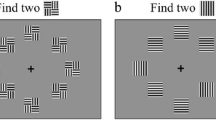Abstract
Worthington (1964) reported detectability differences favoring neutral over taboo four-letter words. He measured the dark-adaptation time necessary, not to recognize, but merely to detect a stimulus. Our aim: to duplicate all the essential features of Worthington’s experiment; the outcome: no significant differences involving word class. Therefore it seems premature to conclude that perceptual defense plays a role in visual detection.
Similar content being viewed by others
References
WORTHINGTON, A. G. 1964. Differental rates of dark adaptation to “taboo” and “neutral” stimuli. Canad. J. Psychol., 18, 257–65.
Author information
Authors and Affiliations
Rights and permissions
About this article
Cite this article
Weintraub, D.J., Krantz, D.H. Non-Differential Rates of Dark Adaptation to “Taboo” and “Neutral” Stimuli. Psychol Rec 18, 63–69 (1968). https://doi.org/10.1007/BF03393743
Published:
Issue Date:
DOI: https://doi.org/10.1007/BF03393743




